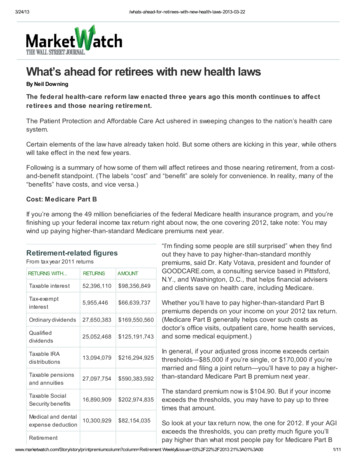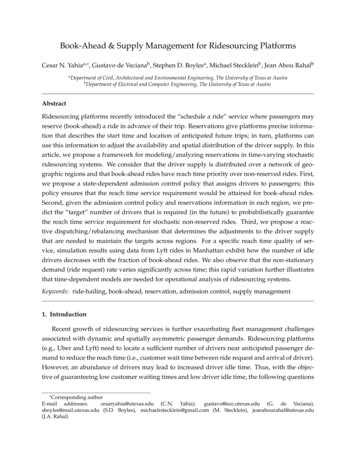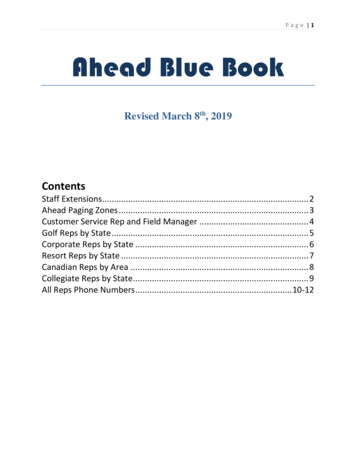
Transcription
aws-2013-03-22What’s ahead for retirees with new health lawsBy Neil DowningThe federal health-care reform law enacted three years ago this month continues to affectretirees and those nearing retirement.The Patient Protection and Affordable Care Act ushered in sweeping changes to the nation’s health caresystem.Certain elements of the law have already taken hold. But some others are kicking in this year, while otherswill take effect in the next few years.Following is a summary of how some of them will affect retirees and those nearing retirement, from a costand-benefit standpoint. (The labels “cost” and “benefit” are solely for convenience. In reality, many of the“benefits” have costs, and vice versa.)Cost: Medicare Part BIf you’re among the 49 million beneficiaries of the federal Medicare health insurance program, and you’refinishing up your federal income tax return right about now, the one covering 2012, take note: You maywind up paying higher-than-standard Medicare premiums next year.Retirement-related figuresFrom tax year 2011 returnsRETURNS WITH.RETURNSAMOUNTTaxable interest52,396,110 98,356,849Tax-exemptinterest5,955,446 66,639,737Ordinary dividends27,650,383 169,550,560Qualifieddividends25,052,468 125,191,743Taxable IRAdistributions13,094,079 216,294,925Taxable pensionsand annuities27,097,754 590,383,592Taxable SocialSecurity benefits16,890,909 202,974,835Medical and dental10,300,929expense deductionRetirement 82,154,035“I’m finding some people are still surprised” when they findout they have to pay higher-than-standard monthlypremiums, said Dr. Katy Votava, president and founder ofGOODCARE.com, a consulting service based in Pittsford,N.Y., and Washington, D.C., that helps financial advisersand clients save on health care, including Medicare.Whether you’ll have to pay higher-than-standard Part Bpremiums depends on your income on your 2012 tax return.(Medicare Part B generally helps cover such costs asdoctor’s office visits, outpatient care, home health services,and some medical equipment.)In general, if your adjusted gross income exceeds certainthresholds— 85,000 if you’re single, or 170,000 if you’remarried and filing a joint return—you’ll have to pay a higherthan-standard Medicare Part B premium next year.The standard premium now is 104.90. But if your incomeexceeds the thresholds, you may have to pay up to threetimes that amount.So look at your tax return now, the one for 2012. If your AGIexceeds the thresholds, you can pretty much figure you’llpay higher than what most people pay for Medicare Part n?column Retirement Weekly&issue 03%2F22%2F2013 21%3A01%3A001/11
3/24/13savingscontribution ws-2013-03-226,504,841 1,140,959For tax y ear 2011, taxpay ers f iled 145.6 million U.S. indiv idualnext year. “This is the time of year (when people are doingtheir taxes) to be looking ahead,” and to see what steps youmight take to try to lessen the impact, said Votava.income tax returns.Keep in mind that the thresholds are frozen through 2019,said Mary Dale Walters, senior vice president for the Allsupf rom Internal Rev enue Serv ice Statistics of Income (SOI) Bulletin,Medicare Advisor, a Medicare plan selection service thatWinter 2013provides one-on-one service to seniors and people withdisabilities to help them identify Medicare plans that bestmatch their needs. (It is offered by Allsup Inc., of Belleville, Ill.) As a result, more and more Medicarebeneficiaries will face the higher Part B premiums as time goes on. The Henry J. Kaiser Family Foundation,a publisher of health policy information based in Menlo Park, Calif., estimates that between 2011 and 2019,the share of Part B enrollees subject to the income-related Part B premium will rise from 5% to 14% (from2.4 million enrollees in 2011 to 7.8 million enrollees in 2019).Source: “Indiv idual Income Tax Returns, Preliminary Data, 2011,”Benefit: Preventive careUnder the old law, a Medicare beneficiary might have paid as much as 160 in cost-sharing for somecolorectal cancer screenings, according to the federal Centers for Medicare & Medicaid Services.But coinsurance and the Medicare Part B deductible have been eliminated for purposes of recommendedpreventive services, including many cancer screenings, according to the CMS.In other words, such preventive services are now “covered in full,” said Joe Baker, president of theMedicare Rights Center, of New York, a national, nonprofit consumer-service organization that works onensuring access to affordable health care for older adults and people with disabilities.In addition, Medicare provides an annual “wellness visit” for Medicare beneficiaries, Baker said. Thewellness visit lets you develop or update a personalized plan to prevent disease and disability, based onyour health and risk factors, according to CMS.The U.S. Department of Health and Human Services said on March 18 that about 34 million Americans intraditional Medicare and in the one-stop Medicare Advantage health plans have received at least onepreventive service, such as an annual wellness visit, at no-out-of-pocket cost because of the health carelaw.Cost: Medicare Part DMedicare Part D is prescription drug coverage that you obtain from a private insurance company. It’ssubsidized by Medicare.When Medicare Part D first took effect, in January 2006, you generally paid the same amount each month—your “premium”—as everybody else.But the amount of your premium depends on the amount of your income. In general, the higher yourincome, the higher your premium.The same income thresholds that apply for Medicare Part B also apply for Medicare Part D, said SocialSecurity expert Kurt Czarnowski. That’s another reason to take a close look at your tax return now, the onefor 2012. If your AGI exceeds the thresholds mentioned above for Medicare Part B, you can pretty muchfigure you’ll pay higher than what most people pay for Medicare Part D next year.The Social Security Administration will send you a letter late this year spelling out your Part B and Part n?column Retirement Weekly&issue 03%2F22%2F2013 21%3A01%3A002/11
aws-2013-03-22premiums for 2013, said Czarnowski, who runs a Social Security consulting firm, Czarnowski Consulting, inNorfolk, Mass.Benefit: Donut holeMedicare Part D doesn’t cover everything. For one thing, there’s a built-in gap in coverage, known as thedoughnut hole. In general, after you and your Part D plan have together spent a certain amount onprescription drugs, you generally get little or no coverage from your insurance. Once spending reachesanother, higher level, the insurance kicks in again.But there is help. If you land in the doughnut hole:You’ll generally pay 47.5% of the cost of brand-name drugs this year and next year.You’ll pay 79% of the cost of covered generic drugs this year, but 72% of the cost of covered genericdrugs next year.In other words, “You get a bit of a break,” Walters said. As the years go by, “you’re paying less and less ofthe cost of the drug,” she said.Last year, more than 3.5 million seniors and people with disabilities who reached the doughnut holereceived discounts on brand-name prescription drugs—discounts totaling 2.5 billion, averaging 706 perbeneficiary, according to CMS. Savings for covered generic drugs for 2.8 million beneficiaries in thedoughnut hole in 2012 totaled 105 million, according to CMS.These savings will increase each year until the coverage gap is closed in 2020. Thus, the Affordable CareAct “improves overall Medicare drug coverage for folks,” Baker said.Cost: Medical expense deductionMost taxpayers claim a lump-sum deduction, known as the standard deduction.But some taxpayers have so many expenses, they make a separate list of their deductions, through aprocess known as itemizing, which is done on Schedule A of your U.S. Form 1040. And among thedeductions you may claim is one for unreimbursed medical and dental expenses.There is a long-standing restriction on the medical expense deduction: you may deduct only thoseexpenses that exceed 7.5% of your adjusted gross income, or AGI.For tax year 2013, the hurdle is higher: It’s now 10% of AGI. “That’s a pretty big jump,” Walters said. And10% is “a pretty high threshold,” Votava said.Suppose your AGI is 80,000 each year. Suppose, too, that you have 8,000 in unreimbursed medical anddental expenses each year. Under the old rules in this example, your deduction was limited to only thoseexpenses exceeding 6,000 (which is 7.5% of your AGI). Thus, your deduction totaled 2,000.Under the new law, however, you get no deduction because your new floor is 8,000, and your 8,000 inunreimbursed medical expenses won’t exceed the new floor under the law.The 10% limitation is in effect for 2013 and later years, so the first time you’ll see its impact is on the returnyou file early next year. But it’s good to know about it now, so you can plan ahead.What if you’re 65 or older? For the years 2013, 2014, 2015 and 2016, if either you or your spouse turns65 before the end of the taxable year, the threshold remains at 7.5% of AGI, according to Congress’s olumn?column Retirement Weekly&issue 03%2F22%2F2013 21%3A01%3A003/11
aws-2013-03-22Committee on Taxation. (So, in general, the 10% threshold won’t kick in until 2017.)Benefit: Medicare savingsMedicare program spending will be reduced by 716 billion over 10 years, starting this year, Baker said,citing Congressional Budget Office estimates.The savings are from measures to control Medicare spending growth, increased benefits for people withMedicare, delivery system reforms, and new sources of revenues for the program, according to theestimates. The savings will also come, Baker said, from reductions in federal subsidies to MedicareAdvantage plans.Taken together, the savings will make Medicare more sustainable—which will translate into slower or lowerincreases in the premiums that Medicare beneficiaries will pay, he said. Part B premiums will continue torise over time, with inflation in health care, but the Medicare program savings has “brought down thegrowth in Part B premiums for everyone,” Baker said.Although Medicare Advantage plan premiums, coinsurance, and benefit amounts “have actually beenpretty stable” in recent years, some insurance companies have indicated they may increase premiums andchange benefits for the 2014 Medicare Advantage plan year, Baker said. It’s not clear whether these willbear out, but if you’re enrolled in a Medicare Advantage plan, you should “keep your eyes open” forpossible changes when the annual notice of changes is mailed in September, he said. “Most of theresponsible players are really in this market for the long-term” and still plan to offer high-quality, low-costproducts for the future, Baker said.Cost: Medicare payroll taxMost workers pay a Medicare tax. It’s equal to 1.45% of each worker’s pay. There is no limit on the amountof wages to which the 1.45% tax rate applies.That hasn’t changed. However, effective for 2013 and later years, you face a Medicare surtax of 0.9% ifyour AGI exceeds a certain threshold, Walters said: 200,000 if you file your federal income tax return as “single,” “head of household,” or “qualifyingwidow or widower with dependent child”; 125,000 if you’re married and file a separate return; and 250,000 if you’re married and file a joint return.Benefit: Mental health coverageFor years, “Medicare has discriminated against mental health benefits” by paying less for them than forphysical health issues, Votava said. But the Affordable Care Act, and other federal laws and regulations,have ushered in parity.In general, your Medicare copay was 50% for mental health care, compared with 20% “for anything else,”she said. But that is changing.For example, assume the cost of a mental health counseling visit for depression is 200, and the cost of adoctor’s visit for blood pressure or a diabetes check is also 200.Under the old rules, you had to pay 100 for the mental health visit, but only 40 for the blood pressure ordiabetes check. Under the new rules, Votava said, your cost for the mental health column?column Retirement Weekly&issue 03%2F22%2F2013 21%3A01%3A004/11
aws-2013-03-22was 80 last year (because your copayment was 40%)is 60 this year (because your copayment is 30%)will be 40 next year (because your copayment will be 20%, the same as for physical issues).As a result, Medicare is making mental health reimbursements “on a par with other medical services,” shesaid. (In general, the changes affect those with traditional Medicare. If you’re enrolled in a MedicareAdvantage plan, check your plan’s rules, Votava said.)Cost: Tax on investment incomeThere is a new Medicare tax. It applies to your “unearned income”—in other words, your net investmentincome, such as taxable interest, taxable dividends, and mutual fund capital gains distributions.The new tax took effect for this year. It’s generally 3.8% on either of the following two items, whichever issmallest:The amount by which your AGI exceeds the applicable threshold ( 200,000 if you’re single, 250,000 ifyou’re married and filing jointly, 125,000 if you’re married and file separately),or,Your net investment income.Benefit: ExchangesCMS is working on building new health insurance marketplaces, known as exchanges, to which consumersand small businesses in every state will have access. (A federal exchange will operate in states that havechosen not to build their own exchange.)They’re important “because we have not had a marketplace where people can buy health insurance,”Votava said. Through an exchange, you’ll be able to evaluate plans and compare plan prices and benefits,all in one place, and do it online, she said. You’ll also be able to find out if you’re eligible for subsidies tohelp you pay.All exchanges will have open enrollment starting in October, for plan years beginning Jan. 1, 2014, Bakersaid. Among the potential beneficiaries: people nearing retirement, in their 50s and early 60s, who don'tnow have the ability to buy health insurance—or affordable health insurance—in many states, he said.The goal is that the exchanges will provide robust options for individuals to acquire health insurancecoverage, “giving them the bridge to Medicare,” Baker said. “If you’re in your early 60s and you don’t havehealth insurance,” you can look for a plan starting in October, he said.The exchanges could be valuable in situations where one spouse has reached 65 and is eligible forMedicare, but the other spouse is younger the only source of health insurance was through the olderspouse’s job, Votava said.Exchanges may also be helpful to people of any age “who want to be entrepreneurial” but who’ve remainedworking for an employer solely to take advantage of the employer’s health insurance, she said.Most employers will continue to offer their own group health insurance plans, but many small businesseswho don't offer coverage will be able to offer it through the exchange, Baker said. Because someemployers will drop coverage, many will continue offering it, and many will offer it for the first time, olumn?column Retirement Weekly&issue 03%2F22%2F2013 21%3A01%3A005/11
aws-2013-03-22actually think there will be a net gain” in the number of people covered, he said.Cost: Flexible spending accountsTrying to stash away some cash in a flexible spending account? You’re now limited to 2,500 a year. “Theydidn’t have limits before,” Votava said. Employers were free to set their own limits, but “there were no limits”under the law, she said.These accounts are sometimes called flexible spending arrangements, health FSAs, or health-care flexiblespending accounts. Whatever the name, the idea is the same: you generally can set aside money fromyour pay into an account, on a pretax basis. You then use that money to pay for many health-relatedexpenses that aren’t covered by your health insurance plan—such as copays, doctor’s fees, prescriptionsand such.The lack of limits in prior years was especially helpful to those who had high health care costs, Votava said.Using an FSA is still valuable, but it’s capped now, at 2,500 per person per year, she said.Cost/Benefit: Tax credits and penaltiesStarting next year, eligible individuals and families will be able to use a new premium tax credit to help themafford health insurance coverage purchased through an exchange.At the same time, each individual will have to either have minimum essential health coverage, or qualify foran exemption, or face a penalty. In essence, “you’re going to get a penalty if you don’t have insurance,”Walters said.Seniors, too, will be required starting next year to have minimum essential coverage or qualify for anexemption. However, Medicare will count as “minimum essential coverage” under the provision. So, too, willretiree health plans, employer-sponsored plans, TRICARE, veterans’ health insurance program, Medicaid,and some others, the IRS says.In general, the penalty—to be levied on your federal tax return—will amount to 95 per adult in 2014, 325in 2015, and 695 in 2015. (Penalties will also apply for children who have no coverage, though there areper-family penalty caps, as well as a number of exceptions.)The hope is that, with the mandate for health insurance coverage, many people will obtain healthinsurance—through their employers, on their own, or through an exchange, for example—and thecombined purchasing power will result in affordable premiums for access, Baker said.In summaryThe federal health care legislation enacted three years ago has already had far-reaching effects onemployers, employees, and retirees. But it’s not over yet. More provisions are on the way. So it’s helpful tohave an idea of what’s head so you can plan ahead.Other pointsThe sweeping changes to the nation’s health care laws are mainly the result not only of the PatientProtection and Affordable Care Act (Public Law No. 111-148), but also a related law, the Health Care andEducation Reconciliation Act of 2010, (Public Law 111–152).Come October, the combination of open enrollment for Medicare and open enrollment for the new stateand federal health insurance exchanges could be “a little messy,” Walters said. “I just think there’s going tobe some confusion out there,” she olumn?column Retirement Weekly&issue 03%2F22%2F2013 21%3A01%3A006/11
aws-2013-03-22Useful linksInternal Revenue Service’s updated list of tax aspects of the Affordable Care ActCongress’s Joint Committee on Taxation report on tax-related provisions of the Affordable Care ActHenry J. Kaiser Family Foundation timeline for implementation of provisions of the Affordable Care ActIRS Notice on limits for flexible spending accounts (FSAs)Allsup explanation of Medicare Part DA website about the Affordable Care Act, developed by Drake Software, that includes a taxpayer creditcalculator, a credit qualification calculator, a taxpayer penalty calculator, and an employer penaltycalculator, along with explanations, FAQs, and linksSocial Security Administration’s summary of key Affordable Care Act provisionsFederal Centers for Medicare & Medicaid Services’ 2012 report on ACAFull text of a compilation of the Affordable Care Act and a related lawIRS’s “Tax Guide for Seniors” booklet (for tax year 2012)Federal government information on exchangesHenry J. Kaiser Family Foundation chart explaining penalt
Medicare Advisor, a Medicare plan selection service that provides one-on-one service to seniors and people with disabilities to help them identify Medicare plans that best match their needs. (It is offered by Allsup Inc., of Belleville, I











